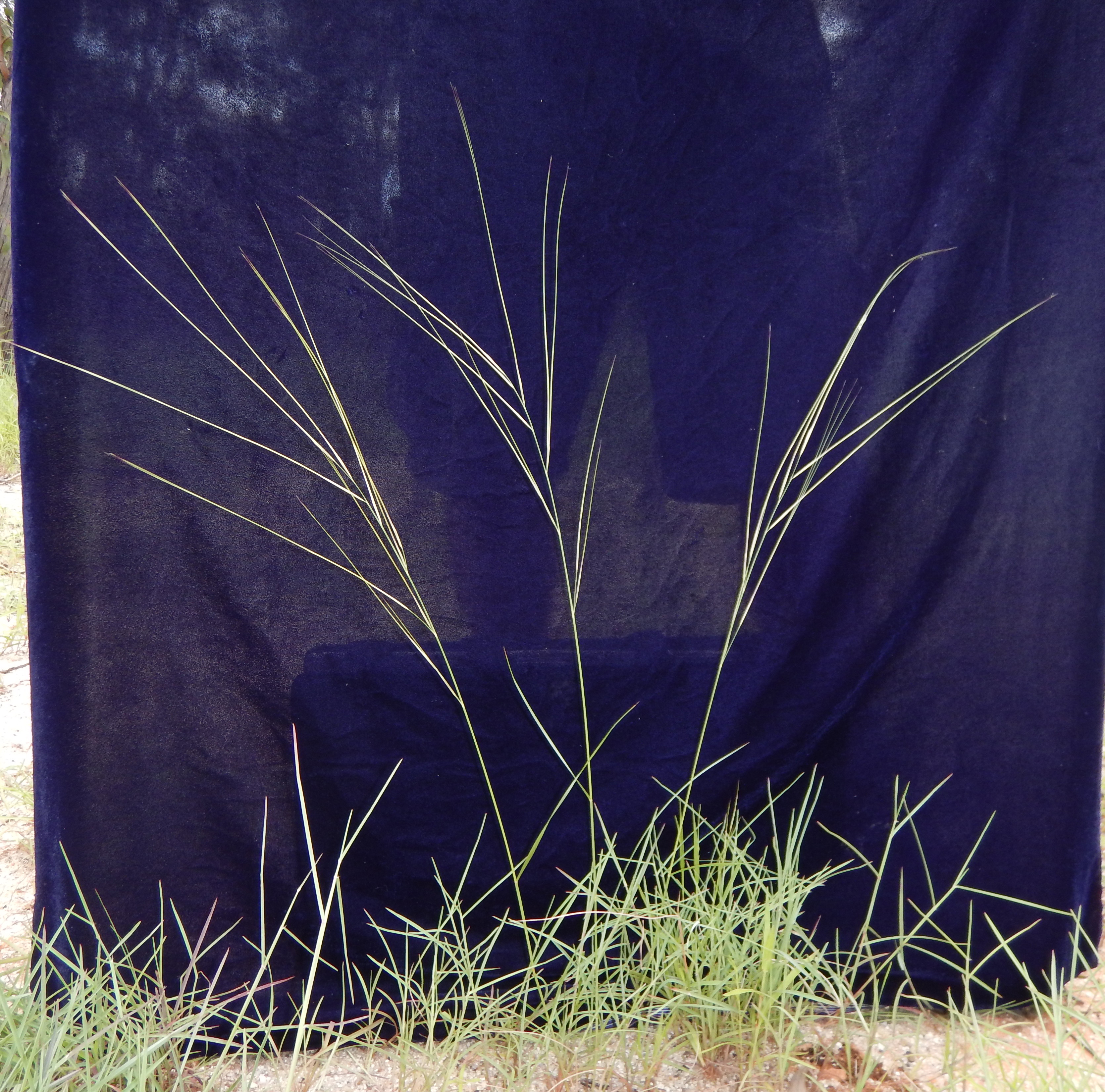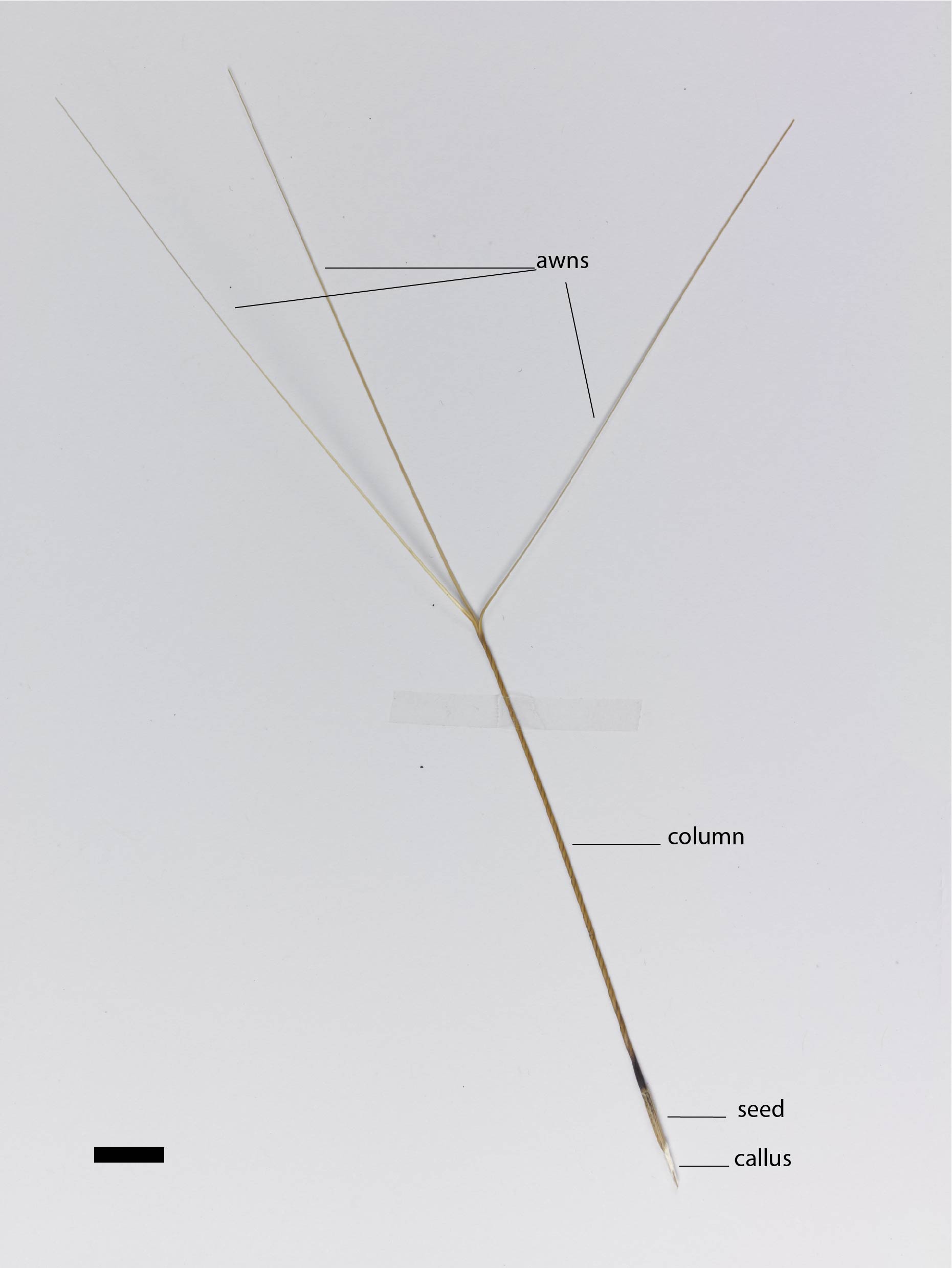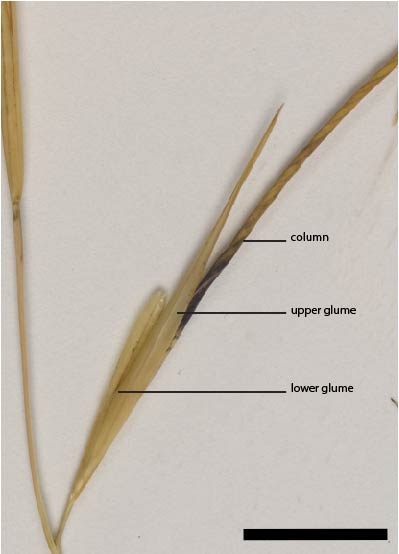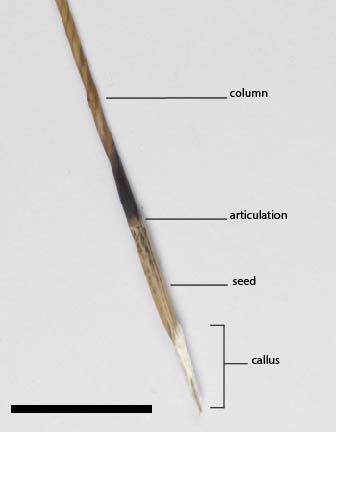Aristida hygrometrica
R.Br.
Northern Kerosene Grass
Corkscrew Grass
This species is widespread across northern Australia. A tufted annual or short-lived perennial to around 80 cm high, with narrow leaves (Fig. 1a & b). The basic flowering units or spikelets are usually arranged singly or in pairs along the flowering culm and held well above the leaves. Each spikelet contains one floret (modified grass flower) which when fertilised gives rise to one seed (Fig. 2). The florets and subsequently seeds in Aristida hygrometrica are characterised by the presence of a long column which separates into three long bristles or awns at the apex. These awns can lie parallel in young florets and become quite divergent in mature seed. Probably useful in dispersal.
Botanical Description
Culms terete; internodes glabrous. Leaf blade conduplicate (folded together along longitudinal axis) or involute (with leaf margins curled inwards), along longitudinal axis curled or flexuous (bent in a loose zig zag form), to 27 cm long and 1.2 mm wide, with bristly hairs. Inflorescence a panicle, more or less open, 14.4-35 cm long, 7-15 cm wide. Spikelets solitary or occasionally paired (with one short and one long stalked spikelet), 1 flowered. Glumes normal (with upper glume longer than the lower) (Fig. 3) notched, glabrous and smooth; lower glume 13.5-23.1 mm long, obtuse, 3-nerved, upper glume 25-42.6 mm long, aristulate or awned, 1-nerved. Lemma 8-16 mm long, with a distinct articulation (seen as a sharp line) with the column (Fig. 4). Column large, 53-85 mm long, 1 mm thick, rough to touch, often twisted in the seed. Awns originating from end of column more or less equal in length, 81-150 mm long, straight, often appressed when in flower and becoming divergent as mature seed. Callus (hardened base of seed or floret) 4-6 mm long, sharp and easily embedded in clothing or wool.
Diagnostic Features
Aristida hygrometrica is readily identified by the very long awns, 80 to 150 mm long, and the very long and thick column 53-85 mm long and 1 mm thick (Fig. 2). This species is quite distinct and is unlikely to be confused with other grass species. Aristida holathera and Aristida contorta are superficially similar as they also possess three large awns and a column, but A. hygrometrica can be readily identified from them by the much larger dimensions of the spikelet, especially the length and thickness of the column. In A. holathera and A. contorta the column is usually less than 50 mm long, occasionally longer (to 65 mm) but then thinner (to 0.3 mm thick).
Natural Values
Considered an increaser species, encouraged by burning and overgrazing (Rolfe et al. 1997; Lazarides 2002; Milson 2000). The sharp callus at the end of the seed likely to be problematic to stock, especially sheep (Lazarides 2002; Milson 2000).
Habitat
Usually found on sandy and alluvial soils in Eucalyptus and Melaleuca woodland and often the dominant grass on extensive river levees (Simon & Alfonso 2011).
Land Management Notes
Considered unpalatable to stock (Milson 2000) with the sharp callus on the basal end of seeds likely to cause irritation.


(MBA9287)



Resources
AVH (2017) Australia’s Virtual Herbarium, Council of Heads of Australasian Herbaria, <http://avh.chah.org.au>, accessed 30 May 2017.
Milson, J. (2000) Pasture plants of north-west Queensland. Information Series Q100015. Queensland Department of Primary Industries.
Rolfe, J., Golding, T. and Cowan, D. (1997) Is your pasture past it? The glove box guide to native pasture identification in north Queensland. Information Series Q197083. Queensland Department of Primary Industries.
Simon, B.K. (1992) A revision of the genus Aristida (Poaceae) in Australia. Austral. Syst. Bot. 5:129-226.
Simon, B.K. (2005) Aristida. Flora of Australia 44B: 9-18.
Simon, B.K. & Alfonso, Y. (2011) AusGrass2, http://ausgrass2.myspecies.info/accessed on [20 March 2017].

